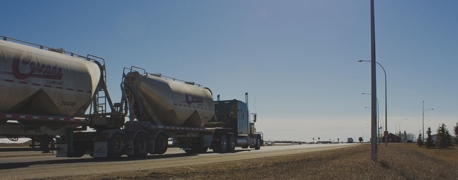Special Exceptions to Hours-of-Service Trucking Laws

Commercial drivers are governed by hours-of-service (HOS) rules, which regulate when and for how long drivers may operate commercial vehicles depending on the type of vehicle, cargo, and whether or not the vehicle is crossing state lines. Federal HOS rules apply to interstate commerce, while state-level regulations apply to intrastate commerce. However, as this article will explore, these rules have numerous exceptions. Some of these exceptions are well-known, while others are less so. Nonetheless, all of them serve to loosen the restrictions on commercial drivers and allow them more flexibility in their work schedules.
Each explanation below outlines the rule first, then describes the kinds of situations where a trucker would be allowed to break that rule. By the end of this article, you'll know (among other things) why trucking is one of the most demanding jobs in the world.
Exceptions to the 11-Hour Driving Rule
The 11-hour rule states that commercial motor vehicle (CMV) drivers are allowed to drive for 11 hours only once they've spent 10 hours off-duty since their last driving period. Drivers are allowed to do non-driving work otherwise, but without a 10-hour off-duty period, they can't drive. However, there's a fairly sensible exception to this: when a driver is in unforeseen and dangerous conditions, they're allowed an additional two hours of drive time to finish their run or find somewhere safe to stop. In total, that means this exception provides truckers with 13 hours of driving in a 16-hour period.
For instance, a trucker might face unforeseen dangerous conditions during a severe snowstorm. When heavy snowfall accumulates on the roads, it reduces visibility, making it difficult for drivers to see other vehicles or any potential obstacles in their way. Additionally, if the temperature drops below freezing, it can cause the roads to become icy or even impassable. In such cases, drivers are allowed additional drive time if it's necessary for them to reach a safe place and stop.
Exceptions to the 8-Hour Driving Rule
After 8 hours of driving, a commercial driver's license (CDL) trucker must take an uninterrupted 30-minute break. The driver can do non-driving work like paperwork or inspections, log sleeper berth time, or do whatever they like—as long as it takes 30 minutes. After the break, they're allowed to drive for an additional 8 hours until the next 30-minute break is required (or they hit another HOS limit).
The exceptions to the 8-hour driving rule include:
- Short-haul drivers, per federal trucking regulations
- Truckers carrying livestock or bees
- Truckers carrying an oversized or overweight load across state lines
- Truckers carrying mobile cranes that can lift more than 30 tons
If you fall under the above categories, you're not required to take a 30-minute break after 8 hours of driving. Additionally, the 8-hour driving rule is not required for short-haul non-CDL drivers, who report to the same work location daily, work within a radius of 150 air miles, and operate vehicles that don't require a CDL.
Exceptions to the 14-Hour Driving Rule
The 14-hour rule is related to the 11-hour rule: after a 10-hour off-duty period, truckers are only permitted to drive within a consecutive 14-hour window before they need another 10 hours of rest. They can do non-driving work outside of that 14-hour window, but all driving has to be completed within 14 hours. For example, if a driver goes on duty at 4:00 AM, they must complete all driving by 6:00 PM that night, no matter how little driving gets done or if they take frequent breaks that day. The rule ensures that a driver behind the wheel is never more than a few hours away from a rest period.
There are a few special exceptions to the 14-hour rule. One exception is that short-haul drivers, or drivers who report to the same location every day, are allowed to extend their driving window to 16 hours once a week. Short-haul non-CDL drivers (see above) are allowed to extend their driving window to 16 hours twice a week.
Split-Sleeper Exceptions
The 14-hour rule allows drivers to split their 10-hour rest period in half as long as one of those breaks includes 7+ hours in the sleeper berth and 2+ consecutive hours of off-duty time for the other break. So a 10-hour rest period can become 7 hours in the sleeper berth/3 hours off-duty, or 8/2, 9/2, and so on. When drivers split their breaks, the 14-hour clock "pauses," allowing drivers to extend their on-duty window.
Using our above example, if you start duty at 4:00 AM, you'd normally need to end your driving window at 6:00 PM. However, if you decide to take a 3-hour break in the middle of the day, your 14-hour window is extended to 9:00 PM. However, following 9:00 PM, the driver must take a 7-hour break in the sleeper berth.
Exceptions to the 60/70-Hour On-Duty Rule
Once truckers have logged a running total of 60 hours on duty in a 7-day period or 70 hours in an 8-day period, they are no longer permitted to drive a CMV. They can continue with non-driving work, so long as those hours are added to the total number of on-duty hours for that day. The total number of on-duty hours includes the current day, plus the previous six or seven days (depending on the schedule your employer puts you on). Once a driver has hit their on-duty limit, they can't drive a CMV until their total is below the limit.
The only exception for the 60/70-hour on-duty rule applies to traveling salespeople as long as they:
- Drive fewer than 40 hours a week
- Work within a 100-mile radius
- Spend less than 50% of their time driving
Exceptions to the 34-Hour Restart Rule
The 34-hour restart is how truckers can reset their 60/70-hour count to 0, no matter how many hours they've logged in the past week. This is less a "rule" and more a relief valve for truckers who want to get back to driving as quickly as possible. All a driver needs to do is take 34 consecutive hours of rest, whether that's in a sleeper berth or logging off-duty time.
Exceptions to the 34-hour restart rule are not required to use a standard grid log to track their hours and fall into two categories: drivers of vehicles requiring a CDL and vehicles not requiring a CDL.
CDL vehicle logging exceptions require:
- Operating within 172.6 miles of where a driver reports for work
- Returning to the work location at the end of the day
- Going off duty within 14 hours of starting the day
- Having 10 consecutive hours off-duty between work shifts
- Driving no more than 11 hours a day
Non-CDL logging exceptions require:
- Operating a property-carrying CMV that does not require a CDL
- Operating within 172.6 miles of where a driver reports for work
- Returning to the starting work location at the end of the day
- Driving no more than 11 hours a day
- Ceasing driving after 14 hours after working 5 days in a 7-day period
Lack of sleep is a serious hazard in the trucking industry. Hours of Service regulations force companies to let drivers rest and recuperate, but even so, HOS laws have plenty of flexible, common-sense exceptions. These exceptions, many of which were added between 2003 and 2020, show how the law has adapted to the trucking industry.
But the underlying idea remains the same: in order to drive safely, truckers need rest.


